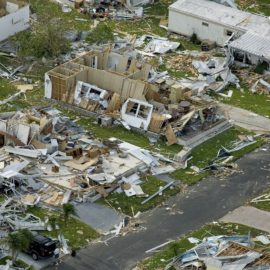
The Great Wall of New Orleans is finished. Are we in Holland?
It’s a modern-day fortress nearly two decades in the making, complete with a “Great Wall of Louisiana” and the biggest pumping station in the world – and it is how New Orleans will do battle against the water that constantly threatens to destroy it. The vast network of levees, gates and floodwalls built to protect the New Orleans area in the wake of Hurricane Katrina’s devastation is finally complete. An event on Friday, days ahead of the start of hurricane season, will formally mark that process, as well as the system’s handover from the Army Corps of Engineers to the state. It’s an engineering marvel and, at a cost of around $12 billion, not to mention another $2.5 billion in related projects, the biggest of its kind by the Corps.
nola.com
We can have confidence in it as long as we realize that it can be overtopped by water occasionally.
Those who have looked closely at the new system, designed to fend off so-called 100-year storms, or those with a 1% chance of occurring in any year, say they have high confidence in it. But they caution it could still be overtopped, and likely will. The chairman of the state’s Coastal Protection and Restoration Authority, which is taking over the system from the Corps, calls it “one of the greatest engineering feats in the history of the world.” What’s different, they say, is that it is now designed to guard against catastrophic breaches, greatly lowering the risk. “The level of protection that is around the Greater New Orleans area is better than at any time in the city’s history,” said Chip Kline. “We’re talking about some of the best protection anywhere along the Gulf Coast and, quite frankly, anywhere in the country.” Still, some residents, reeling from the failures of the federal levees after Katrina in 2005, are putting a critical eye on the finished system. “Personally, I don’t trust it fully,” said Willie Converse, 58, as he took a break from yard work at his Lower Ninth Ward home not far from the Industrial Canal breach, where a wall of water swept through and wiped out the neighborhood.
Others disagree but they worry about the cities reaction when it is overtopped.
Others said the design seems solid. Still, given Louisiana’s history of patronage and mismanagement, they were concerned with local authorities taking responsibility as well as issues such as the rising cost of insurance. “The levees are probably going to hold,” said Al Bostick, 70, as he sat with a couple friends at Parlay’s bar in Lakeview, inundated in 2005 by the 17th Street Canal breach. But, he said, what will take its toll is “all the other stuff.”
The completion was low key. The city is now largely out of the picture.
Friday’s event is largely symbolic. The state has been gradually assuming control of the system for years as its various components have been built, and its main pieces have long been in place. They passed a major test in withstanding Hurricane Ida last year, though a slight shift in path could have posed a greater risk. The last parts to be completed mainly involved levee armoring, said Corps spokesman Ricky Boyett. Forecasters are predicting another active storm season this year, which could mean a further test for the system. State officials are stressing to residents that it will not eliminate all risk, and that people should make plans to evacuate if needed. The handover means that two New Orleans-area flood protection authorities, the Southeast Louisiana Flood Protection Authority (East and West), will now be responsible for maintenance and operation. Estimates put those costs at around $7.8 million annually for the west bank and $25 million for the east bank. Local officials and experts expressed confidence this week in those authorities, the result of reforms passed after Katrina. The construction price tag will largely be billed to the federal government, with the state picking up about a third of that cost. The convoluted name for the system doesn’t exactly convey its importance to the region: the Hurricane and Storm Damage Risk Reduction System, referred to as the HSDRRS.
The various components follow.
The individual projects within it are, in some cases, enormous in scale: The “Great Wall of Louisiana,” otherwise known by its technical name, the IHNC-Lake Borgne Surge Barrier. It’s a 1.8-mile barrier that can be closed during storms. It spans the area where the Gulf Intracoastal Waterway and the Mississippi River Gulf Outlet meet east of the city. Cost: $1.2 billion, West Closure Complex, near the confluence of the Harvey and Algiers canals on the Intracoastal Waterway. The pumping station at the complex is the biggest in the world. Cost: $1.1 billion and The system spans a 133-mile perimeter. There are also 70 miles of internal risk reduction structures. State and local officials will also need to monitor subsidence of the soil atop which the levees sit, and when required, lift the levees back to their 100-year elevation, federal and state officials say. Beyond that, levee armoring is in place to prevent erosion, as occurred in Katrina. For that reason, those familiar with the system said this week while it is high enough for 100-year storms, it remains effective well beyond that, and can hold even if the system is overtopped. “The system as it’s designed should really help the city weather and survive an event that’s larger than what one would expect to occur once every 100 years,” said Rick Luettich, a University of North Carolina at Chapel Hill professor who co-developed a storm surge model the Corps used in designing the system and was a member of the east bank flood protection authority for eight years. Ed Link, a University of Maryland professor who led the task force that investigated the breaches in Katrina, said he has “a heck of a lot of faith in the system” due to the protections in place beyond the 100-year elevation level to guard against breaches. “You could still call it a 100-year design,” he said. “But it was a 100-year design with an awful lot of buffer built in for uncertainty.”
The Governor, the Mayor and others will be at the ceremony.
Gov. John Bel Edwards, New Orleans Mayor LaToya Cantrell and members of the state’s congressional delegation are expected to attend Friday’s event at the Lake Borgne Surge Barrier. While marking the completion of the entire system, the event is also intended to raise awareness of the risks of this year’s hurricane season and to urge residents to prepare. For the CPRA’s Kline, the handover marks a significant milestone. Still, he noted that further protection is needed for communities outside of the new system. A range of protection projects, such as the West Shore Lake Pontchartrain project for the River Parishes and Upper Barataria project for northern Lafourche, are at various stages of development “There are other areas across south Louisiana that deserve the same level of protection that the city of New Orleans is getting,” he said. For Converse, the Lower Ninth Ward resident, past memories are hard to overcome. He grew up in the house destroyed by Katrina, and has had issues with his new home, where he lives with his brother and 85-year-old mother, obtained through the Make It Right Foundation. Overgrown, empty lots remain a dominant feature of his area. “I was going to move completely away from here,” he said, but doing so is too expensive.
Since the hurricane season starts shortly my hope is that we will have to test the “great wall” but the odds are against me.


